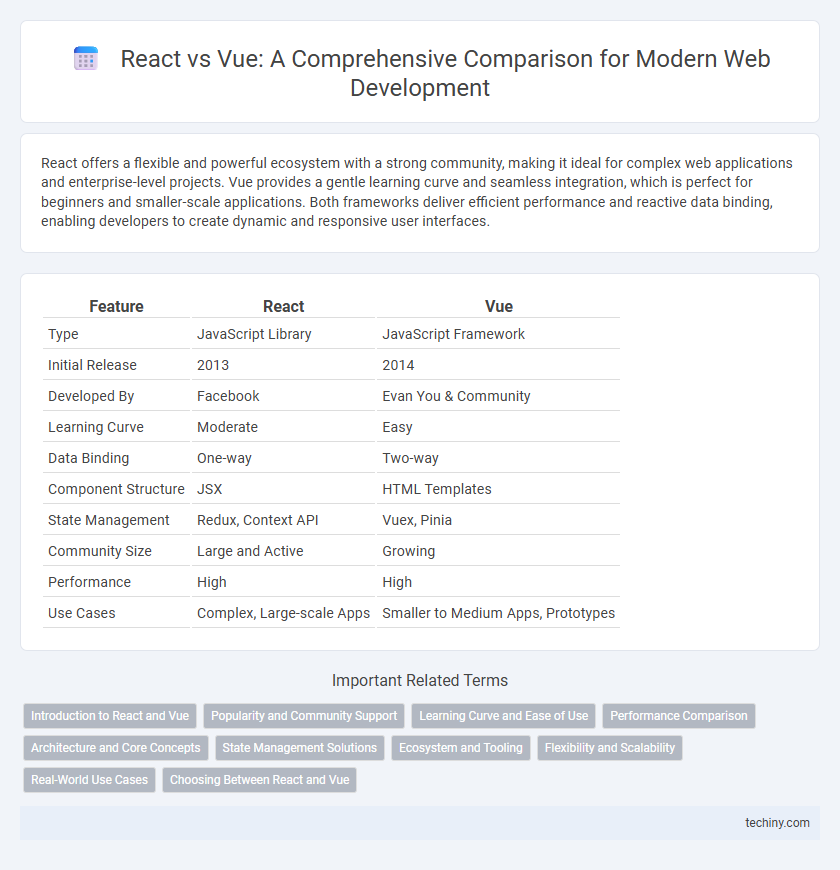React offers a flexible and powerful ecosystem with a strong community, making it ideal for complex web applications and enterprise-level projects. Vue provides a gentle learning curve and seamless integration, which is perfect for beginners and smaller-scale applications. Both frameworks deliver efficient performance and reactive data binding, enabling developers to create dynamic and responsive user interfaces.
Table of Comparison
| Feature | React | Vue |
|---|---|---|
| Type | JavaScript Library | JavaScript Framework |
| Initial Release | 2013 | 2014 |
| Developed By | Evan You & Community | |
| Learning Curve | Moderate | Easy |
| Data Binding | One-way | Two-way |
| Component Structure | JSX | HTML Templates |
| State Management | Redux, Context API | Vuex, Pinia |
| Community Size | Large and Active | Growing |
| Performance | High | High |
| Use Cases | Complex, Large-scale Apps | Smaller to Medium Apps, Prototypes |
Introduction to React and Vue
React, developed by Facebook, is a widely adopted JavaScript library designed for building dynamic user interfaces with a component-based architecture and a virtual DOM for efficient rendering. Vue, created by Evan You, is a progressive JavaScript framework known for its simplicity and flexibility, offering reactive data binding and a template-based syntax that facilitates rapid development. Both React and Vue support reusable components and state management, making them popular choices for modern web development projects.
Popularity and Community Support
React, maintained by Facebook, boasts a larger community with extensive resources, libraries, and third-party tools, making it highly popular among developers for scalable applications. Vue, created by Evan You, has rapidly gained popularity due to its simplicity and progressive framework, supported by a passionate and growing community that excels in documentation and ease of integration. In terms of community support, React's ecosystem is more mature with frequent updates, while Vue offers a lighter learning curve and strong adoption in Asia and the open-source sector.
Learning Curve and Ease of Use
React offers a steeper learning curve due to its reliance on JSX and a broader ecosystem requiring familiarity with external libraries and state management tools. Vue provides a gentler introduction with a more intuitive template syntax and built-in features, allowing developers to quickly build applications without extensive setup. For beginners, Vue is often preferred for ease of use, while React suits those needing flexibility and scalability as projects grow.
Performance Comparison
React leverages a virtual DOM diffing algorithm that optimizes rendering by updating only the components that change, resulting in efficient performance for complex applications. Vue also employs a virtual DOM but benefits from a more granular reactivity system that tracks dependencies during render, often delivering faster updates with less overhead in smaller to medium-sized apps. Benchmark tests indicate Vue can have lower memory usage and quicker initial render times, while React excels in handling large-scale state management and asynchronous data flows.
Architecture and Core Concepts
React employs a component-based architecture centered on a virtual DOM and unidirectional data flow, emphasizing JSX for UI rendering and a declarative programming model. Vue combines an adaptable architecture with a reactive data-binding system and a templating syntax that separates concerns, featuring a virtual DOM for efficient updates and a flexible component system. Both frameworks prioritize state management and component reusability but differ in complexity, learning curve, and ecosystem integration.
State Management Solutions
React primarily relies on external libraries like Redux and MobX for state management, offering robust solutions for complex applications with large-scale data flow. Vue provides Vuex as its official state management library, designed to integrate seamlessly with Vue's reactivity system, enabling simpler state handling for medium to large projects. Both frameworks support reactive state updates, but Vuex's mutations and actions pattern offers a more structured approach compared to React's flexible, middleware-driven options.
Ecosystem and Tooling
React offers a vast ecosystem with extensive libraries, robust developer tools like React Developer Tools, and seamless integration with popular state management solutions such as Redux and MobX, making it ideal for large-scale applications. Vue provides a more integrated tooling experience through official libraries like Vue Router and Vuex, combined with a progressive framework design that facilitates gradual adoption and a strong CLI for rapid project scaffolding. Both ecosystems support TypeScript and offer comprehensive community-driven plugins, but React's larger market share often results in more third-party tools and resources.
Flexibility and Scalability
React offers high flexibility with its component-based architecture and extensive ecosystem, enabling developers to build scalable applications tailored to specific project needs. Vue provides a progressive framework that balances simplicity with scalability, allowing incremental integration and adaptation in both small and large-scale projects. Both frameworks support modular development, but React's vast community and third-party libraries give it an edge in handling complex, scalable web applications.
Real-World Use Cases
React excels in large-scale enterprise applications due to its robust ecosystem and flexibility, powering platforms like Facebook and Instagram with complex state management and dynamic UI rendering. Vue shines in progressive web apps and smaller projects, favored for its gentle learning curve and ease of integration into existing codebases, demonstrated by Alibaba and Xiaomi's frontend implementations. Both frameworks enable efficient component reuse and responsive performance, but React's extensive community support suits scalability while Vue's simplicity accelerates rapid development in real-world scenarios.
Choosing Between React and Vue
Choosing between React and Vue depends on project requirements, developer experience, and ecosystem support. React offers a robust component-based architecture with extensive community resources and third-party libraries, ideal for large-scale applications. Vue provides a gentle learning curve, flexible integration options, and reactive data binding, making it suitable for both small projects and gradual adoption in existing codebases.
React vs Vue Infographic

 techiny.com
techiny.com